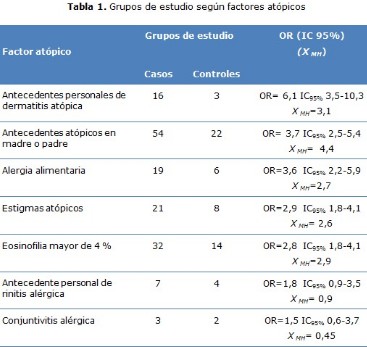Atopic risk factors for recurrent wheeze in children under five years old
Keywords:
Palabras claves, sibilancia recurrente, factor de riesgo, dermatitis atópica. marcha alérgica.Abstract
Background: the recurrent wheeze is the presence of the three or more episodes of wheeze and is the main manifestation of asthma in children under five years old.
Objective: to determine the atopic factors associated with recurrent wheeze in children less than five years.
Methods: a case-control study was made in Guáimaro, Camagüey province, Cuba from June 2015 to January 2017. The cases were 114 children under five years old with diagnostic of recurrent wheeze and the same number of children without diagnostic of recurrent wheeze were the controls. The information was obtained through a questionnaire applied to parents of children.
Results: the diagnosis of allergic dermatitis (OR=6,1,.IC95%3,5-10,3), history of atopic disease in mother o father (OR=3,7IC95% 2,5-5,4), food allergy (OR 3,6IC95% 2,2-5,9), cutaneous atopic stigma (OR 2,9 IC95% 1,8-4,1), eosinophilia > 4 % (OR=2,8IC95%1,8-4,1) and allergic march (OR=8,4IC95% 4,7-14,3) showed significant associations with recurrent wheeze. The presence of two atopic factors increased in 8 times the risk of recurrent wheeze (OR=8,3; IC95% 5,4-12,2), three to four factors elevated the possibility in more than 12 times (OR=12,2; IC95% 7,6-19,2) and five o more increased the risk almost 20 times (OR=19,8; IC95% 10,5-36,8).
Conclusions: the risk factors for recurrent wheeze were the diagnosis of allergic dermatitis, family history of atopic disease, food allergy, cutaneous atopic stigma, eosinophilia higher than 4% and allergic march. The risk of recurrent wheeze increased proportionally to the number of the atopic factors.
DeCS: RESPIRATORY SOUNDS; RISK FACTORS; DERMATITIS, ATOPIC; CHILD, PRESCHOOL; CASE-CONTROL STUDIES.
Downloads
References
1.Aguilera Zamarroni F, Huerta López JG. Sibilancias tempranas recurrentes y factores de riesgo para el desarrollo futuro de asma. Allergy Immunol. 2016; 25(1):12-23.
2.Mallo Villablanca J. Asma del Lactante: Actualización. Rev Med Clin Condes. 2017;28(1):37-44.
3.Restrepo Gualteros SM, Villamil Osorio M, Rodríguez Martínez CE. Fenotipos del asma en Pediatría. Rev Colombiana Neumol. 2015;27(3):254-57.
4.Úbeda Sansano MI. Tratamiento de las sibilancias recurrentes. Rev Pediatr Aten Primaria Supl. 2017;(26):27-34.
5.Úbeda Sansano MI, García JM, Castillo Laita JA. Pautas de actuación ante un niño menor de cuatro años con sibilancias. FAPapMonogr. 2015;1:337-45.
6.Oviedo Quirós J, Lorz Ulloa P, Porras Oviedo AL. Prevalencia de atopias en estudiantes de Odontología. ODOVTOS-Int J Dental Sc. 2016;18:119-128.
7.Silva Rojas M, Martínez Milián Y. Índice predictivo de asma y factores asociados en menores de cinco años con sibilancias recurrentes. Rev Electrónica Dr. Zoilo E. Marinello Vidaurreta [Internet]. 2016[citado 20 May 2017];41(1):[aprox. 5 p.]. Disponible en: http://revzoilomarinello.sld.cu/index.php/zmv/ article/view/524
8.Lustosa WA, Vieira Melo ML, Ubiraídys de Andrade I, Alves de Sousa MN, Abreu LC, Valenti VE, et al. Riskfactorsforrecurrentwheezing in infants. J Hum Growth Develop. 2013; 23(2): 203-208.
9.Rivero Gairaud JI. Dermatitis Atópica. Rev Méd Costa Rica Centroamerica. 2016;LXXIII(620):711–716.
10.Acón Ramírez E. Dermatitis Atópica. Rev Méd Costa Rica Centroamérica. 2014;LXXI(610):239–242.
11.Valcárcel Vidal I, Razón Behar R, Ramos Carpente LT, Cantillo Gámez HM, Reyes López MC, Armas Morales I, et al. Sibilancias recurrentes en el niño Rev Cubana Pediatr [Internet]. 2008 [citado 20 May 2017];80(4):[aprox. 5 p.]. Disponible en: http://www.bvs.sld.cu/revistas/ped/vol80_4_08/ped01408.pdf
12.Venero Fernández SJ, Suárez Medina R, Mora Faife Esperanza de la C, García García G, Del Valle Infante I, Gómez Marrero L, et al. Factores asociados a la sibilancia recurrente en lactantes de La Habana, Cuba. Rev Cubana Hig Epidemiol [Internet]. Abr 2015 [citado 20 May 2017];53(1):[aprox. 5 p.]. Disponible en: http://scielo.sld.cu/scielo.php?script=sci_arttext&pid=S1561-30032015000100004
13.Sousa RB, Medeiros D, Sarinho E, Rizzo JÂ, Silva AR, Bianca AC de la. Risk factors for recurrent wheezing in infants: a case-control study. Rev Saude Publica. 2016;50:15.
14.Sánchez-García S, Cipriani F, Ricci G. Food Allergy in childhood: phenotypes, prevention and treatment. Pediatr Allergy Immunol. 2015: 26;711-719.
15.Toro-Monjaraz EM, Ramírez-Mayans JA. Alergia alimentaria en pediatría. Rev Gastroenterol Méx. 2016;81(Supl 1):32-34.
16.Segundo Consenso Mexicano de Asma en Pediatría. Acta Pediatr Mex. 2002; 23 (supl. 1):S1-S39.
17.Orraca Castillo O, González Valdés LM, Casanova Moreno MC, Marimón Torres ER, Rodríguez Machín LR. Factores peri y postnatales relacionados con el asma bronquial en niños. Rev Ciencias Médicas. May-Jun 2014;18(3):375-387.
18.La marcha atópica. Bol Inf Clín Terap Acad Nac Med. 2012;21(1):6-8.
19.Garnica Cruz P, Zúñiga Lagunes CG, Huerta López JG. Actualidades en el tratamiento sistémico de la dermatitis atópica en el paciente pediátrico. Asth Alle Imm Pediatr. Ene-Abr 2015;24(1):18-28.
20.Rosario Rojas A, Arnoldo Quezada L. Relación entre dermatitis atópica y alergia alimentaria. Rev Chil Pediatr. 2013;84(4):438-450.

Published
How to Cite
Issue
Section
License
Copyright: Camagüey Medical Archive Magazine, offers immediately after being indexed in the SciELO Project; Open access to the full text of the articles under the principle of making available and free the research to promote the exchange of global knowledge and contribute to a greater extension, publication, evaluation and extensive use of the articles that can be used without purpose As long as reference is made to the primary source.
Conflicts of interest: authors must declare in a mandatory manner the presence or not of conflicts of interest in relation to the investigation presented.
(Download Statement of potential conflicts of interest)
The Revista Archivo Médico de Camagüey is under a License Creative Commons Attribution-Noncommercial-No Derivative Works 4.0 International (CC BY 4.0).
This license allows others to distribute, to mix, to adjust and to build from its work, even for commercial purposes, as long as it is recognized the authorship of the original creation. This is the most helpful license offered. Recommended for maximum dissemination and use of licensed materials. The full license can be found at: https://creativecommons.org/licenses/












 22 julio 2025
22 julio 2025